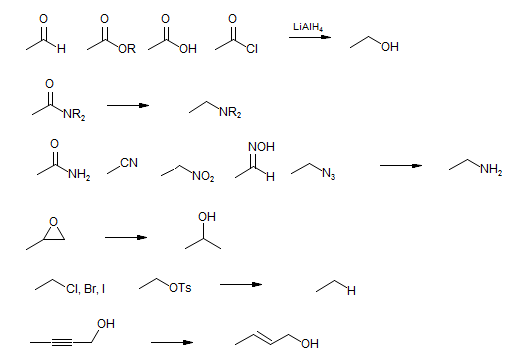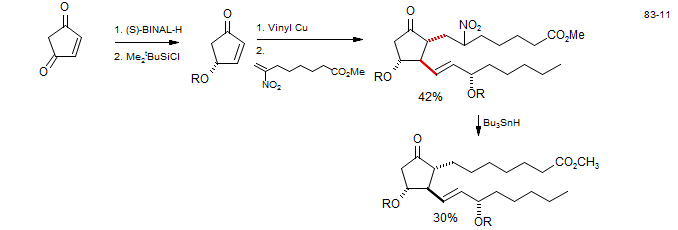Aluminum Hydrides
Reductions by Metal Alkoxyaluminum Hydrides,
J. Malek, Org. React. 1985, 34, 1; 1988, 36, 249.
Asymmetric Aluminum Hydride Reductions:
Asymmetric Reductions with Chiral Complex Aluminum Hydrides and Tricoordinate Aluminum Reagents,
Haubenstock, H. Top. in Stereochemistry, 1983, 14, 213.
Reduction with Chiral Modifications of Lithium Aluminum Hydride,
E. R. Grandbois, S. I. Howard, J. D. Morrison in "Asymmetric Synthesis" Vol. 2, J. D. Morrison, Ed., Academic Press, 1983.
Lithium Aluminum Hydride
LiAlH4 and its analogs are the most powerful nucleophilic hydride reducing agents available. These reagents must be used in ether solvents, as they react violently with water and alcohols, and there is a substantial fire hazard while using them. The reagent NaH2Al(OCH2CH2OMe)2 has similar reactivity and was developed to reduce the fire hazard. LiAlH4 will reduce all common unsaturated functional groups except for unactivated alkenes and alkynes, and is also a powerful SN2 reducing agent of halides and sulfonates.

LiAlH4 is usually the reagent of choice for the reduction of carboxylic acids and esters to primary alcohols, and the reduction of amides to amines.
Farnesol: Yu, J. S.; Kleckley, T. S.; Wiemer, D. F. Org. Let. 2005, 7, 4803

Phenserine: Rigby, J. H.; Sidique,S. Org. Lett. 2007, 7, 1219 DOI

Propargyl alcohol reduction
LiAlH4 and the closely related NaAlH2(OR)2 will reduce the triple bond of propargyl alcohols to form a trans vinyl alane, which can be protonated or halogenated (as in the example below). Englerin A: Nicolaou, K. C.; Kang, q.; Ng, s. y.; Chen, D. Y.-K. J. Am. Chem. Soc. 2010, 132, 8219-8222. DOI

Although isolated triple bonds are not usually reduced, in the special case below both triple bonds are reduced, presumably through a chelation effect. Cecropia Juvenile Hormone: Corey, E. J.; Katzenellenbogen, J. A.; Roman, S. A.; Gilman, N. W. Tetrahedron Lett. 1971, 1821. DOI

Enantioselective Reductions
Binaphthol aluminum hydrides: Noyori, JACS 1979, 101, 3129;

Prostaglandin E1: Tanaka, T.; Toru, T.; Okamura, N.; Hazato, A.; Sugiura, S.; Manabe, K.; Kurozumi, S.; Suzuki, M.; Kawagishi T.; Noyori, R. Tetrahedron Lett. 1983, 24, 4103-4104. DOI

Gallium analog of BINAL-H: Catalytic reaductions. Ford, A.; Woodward, S. Angew. Chem. Int. Ed. 1999, 38, 335.

Alanes - Diisobutylaluminum Hydride
Applications of Diisobutylaluminum Hydride and Triisobutylaluminum Hydride as Reducing Agents in Organic Synthesis,
Winterfeldt, E. Synthesis 1975, 617.
By far the most important hydridoalane in synthetic chemistry is diisobutylaluminum hydride (DIBALH). Its most common use is the reduction of α,β-unsaturated aldehydes, ketones, esters and carboxylic acids to alcohols with minimum competing 1,4-reduction. Also useful are the hydroalumination of alkynes as a route to vinyl halides, and the partial reduction of nitriles to give aldehydes on hydrolysis. Under carefully controlled low-temperature conditions DIBALH reduction of esters can be stopped at the aldehyde stage (presumably aluminum coordination stabilizes the tetrahedral intermediate), although usually conversion of esters to aldehydes is done by complete reduction followed by oxidation of primary alcohol to aldehyde.
Mesembrine: Stevens, R. V.; Lesko, P. M.; Lapalme, R. J. Org. Chem. 1975, 40, 3495.

Reduction of Weinreb amide - Rhyzoxin D: Jiang, Y.; Hong, J.; Burke, S. D. Org. Lett. 2004, 6, 1445

Alkyne hydroalumination - Deplancheine: Overman, L. E.; Malone, T. C. J. Org. Chem. 1982, 47, 5297.
